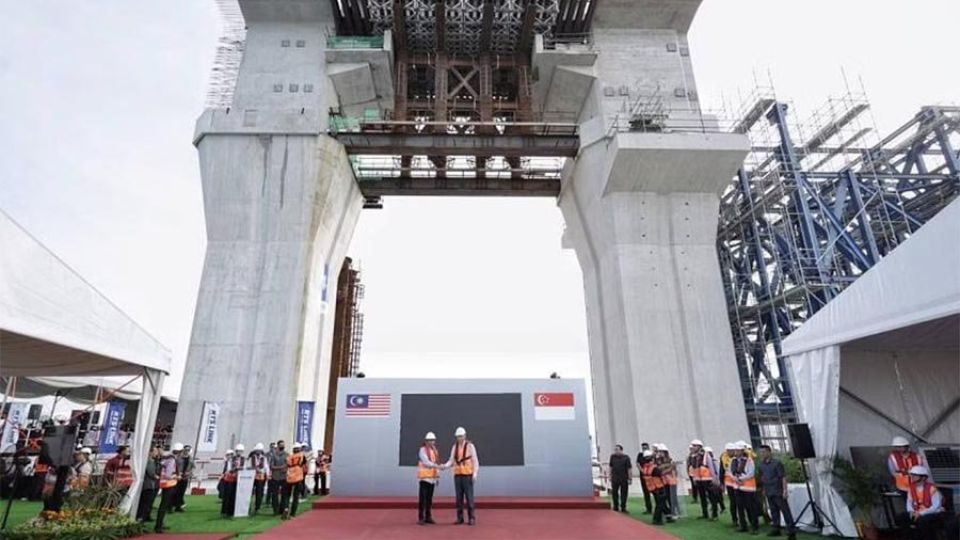January 12, 2024
JOHOR BAHRU – About two-thirds of civil infrastructure works on the Singapore side of the Johor Bahru-Singapore Rapid Transit System (RTS) Link have been completed, with passenger service slated to start by December 2026.
On the Malaysian side, the project has reached 65 per cent completion as at Dec 31, 2023.
In a joint statement, the transport ministries of both countries said a significant construction milestone was reached at the end of December 2023, with the completion of a 17.1m-long concrete span connecting the Singapore and Malaysian ends of a rail viaduct that will run across the Strait of Johor.
On Jan 11, Prime Minister Lee Hsien Loong and Malaysian Prime Minister Anwar Ibrahim met at the strait in a ceremony to commemorate the milestone.
The two leaders signed plaques symbolising the shared commitment of both countries to deliver the cross-border rail link, which was delayed and suspended for six months at one point, before new terms were agreed and the project resumed.
PM Lee later wrote on Facebook that the span “bridges our two piers, and brings our friendship and bilateral ties closer”.
He noted that he and Datuk Seri Anwar had emphasised win-win cooperation when they last met in Singapore at the Singapore-Malaysia Leaders’ Retreat in October 2023.
“I am glad that we are making progress,” said PM Lee.
“As we approach the 60th anniversary of bilateral relations next year, I look forward to both countries charting new areas of cooperation, including in trade and investment, tourism, innovation, and the digital and green economies.”
The transport ministries said passenger service for the RTS Link is targeted to start by December 2026.
When ready, the 4km rail shuttle service will be able to carry up to 10,000 people per hour in each direction between Bukit Chagar in Johor and Woodlands North, absorbing at least 35 per cent of the human traffic at the Causeway and easing congestion on the land link.
According to Malaysia’s Mass Rapid Transit Corporation (MRT Corp), the service will operate from 6am to midnight, with trains running at four-minute intervals during peak hours.
With the connecting span now done, construction work for the rest of the RTS Link’s civil infrastructure – which includes the rail viaduct, tunnels, stations and Customs buildings – will continue on both sides, the transport ministries said.
In a press conference after the ceremony, Malaysian Transport Minister Anthony Loke said the RTS infrastructure is on schedule to be completed by December 2024.
“We are 100 per cent confident that the RTS Link project will be completed and operational by Jan 1, 2027,” he added.
Once finished, the civil structures will be handed over to RTS Operations, a joint venture formed in 2020 between Singapore rail operator SMRT and Malaysian public transport firm Prasarana, for rail systems to be installed.
Singapore’s Acting Transport Minister Chee Hong Tat said this next phase will entail the installation and testing of railway tracks as well as signalling and communications systems.
Architectural works to fit out the respective terminus stations will be carried out at the same time, along with electrical and mechanical works.
This phase will require close coordination between both countries, Mr Chee added.
In their statement on Jan 11, the transport ministries highlighted the challenges that went into constructing the connecting span in the middle of the strait.
Weighing 340 tonnes, the span was built using temporary support structures consisting of steel beams and hydraulic jacks that had to be lined up precisely. The structures were erected at a height of more than 26m above sea level.
The ministries said prolonged exposure to the elements and conducting installation works requiring millimetre precision under strong wind conditions presented an added challenge.
They added that these works had to be monitored closely to ensure they were being carried out safely and in a timely manner.
On Singapore’s end, the Land Transport Authority (LTA) said construction works for the Customs, Immigration and Quarantine (CIQ) building in Woodlands North, the 730m-long rail viaduct and connecting tunnels are progressing well.
These works started in 2021 after Singapore broke ground on the project in January that year.
LTA said all 12 pile caps, which form the foundation for the piers that support Singapore’s section of the RTS viaduct, have been completed, and construction of the viaduct piers is ongoing.
The RTS Link station in Woodlands North is being built at a maximum depth of 28m, and an underground Basement 3 linkway connecting the station to the CIQ building has been completed as well.
A key feature of the cross-border rail link is that the CIQ facilities of both Singapore and Malaysia will be co-located at the Woodlands North and Bukit Chagar stations. This means passengers need to clear immigration only at their point of departure.
Malaysia’s MRT Corp said the pier columns for its section of the viaduct in the Strait of Johor are substantially completed.
On land, construction of the RTS Link train depot in Wadi Hana, Johor, is almost at the halfway mark, and piling works for the CIQ complex in Bukit Chagar are done.
Bukit Chagar station is about 40 per cent finished.


